This post contains affiliate links. We may get paid an affiliate commission if you buy something or take an action after clicking one of the links on this web page.
I love me a big knife. I particularly love a big, well designed knife. I recently acquired two similar big folding knives, and I’m going to do a full review of one and complain about the other one.
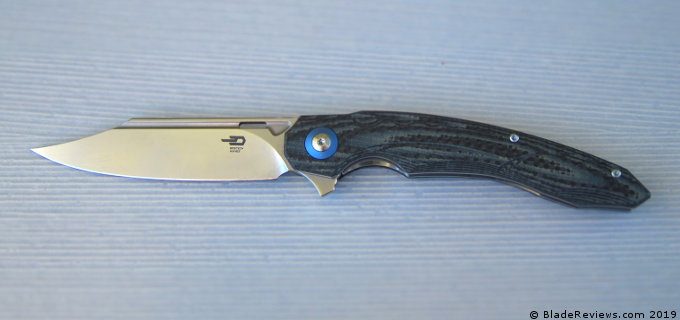
Buy the Bestech Fanga at BladeHQ
The Bestech Knives Fanga is the newest design from Polish knife designer Grzegorz Grabarski (AKA Kombou on Instagram), who’s on a real hot streak lately. In the last couple of years, a total of seven of his designs have been produced by BRR Knives in Poland, Custom Knife Factory in Russia, and five models from Bestech in China. Bestech’s website describes their company as “a professional manufacturer and exporter of medium and high quality knives in China for OEM in the past 10 years.”
I had never heard of Bestech until about a year ago, but apparently they’ve been making knives for other brands for a decade. Everything I’ve seen of theirs has been very well made, particularly the Bestech Malware, which I previously reviewed. The Fanga is also his least expensive folder to date, with the G10 handled version retailing for $80 and the carbon fiber/G10 version (the subject of this review) for $102 at BladeHQ.
General Dimensions and Blade Details
The Fanga is indeed a big knife at 9.375 inches (238 mm) open, weighs 4.75 ounces (135 grams), and has a 4 inch (102 mm) clip point blade that brings to mind a scimitar or Bowie knife. Research into scimitars and Bowie knives led me down a very deep internet rabbit hole, and when I climbed out I had two salient pieces of information:
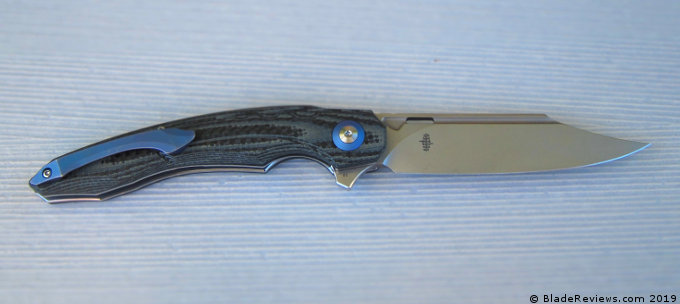
1) curved blades are designed to aid in draw cuts, where the blade is being pulled across what it’s cutting. The outward curve of the blade not only provides a longer surface area to cut with than a straight edged blade of the same overall length, but the curved shape is also ergonomically designed to cut deeper than a straight blade when using a slashing motion. And
2) searching for information on Bowie knives led me to YouTube videos of the Mountain Dew drinking maniac Tom O’Dell on the QVC Cutlery Corner cable TV show from the late 90’s / early 2000’s. He would say “bowie” a hundred times an hour with amazing enthusiasm: “We have a set of 14 B o o o o o – ee knives with genuine jigged stag bone handles and top quality mirror polished stainless steel for only $39.99!” I have fond memories of watching that show at 2am in the 90’s- and now, even without the bong, it’s still captivating viewing.
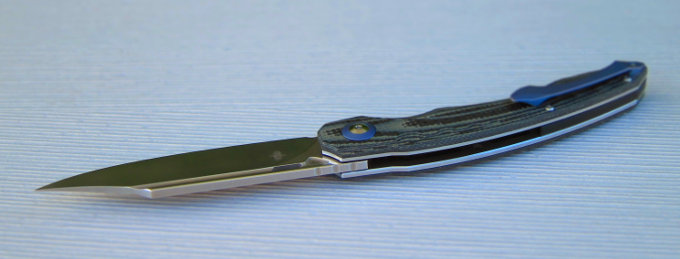
The blade has 3.875 inches (98 mm) of sharpened edge, and it’s made of D2 tool steel. D2 was patented in 1927, and was primarily used for industrial cutting tools until the mid 1960’s when it started showing up in high-end knives of the time. D2 is a good middle of the road steel. It’s not quite rust-proof stainless steel (not enough chromium), it’s not as fine-grained as modern powdered steel (not easy to sharpen to a fine edge), but on the upside it’s a pretty “hard” steel, meaning it can take a lot of abuse without deforming. That quality of hardness gives D2 good edge retention, but is notoriously hard to sharpen to a very fine edge. I’ve been able to get a good sharp edge on mine using my Wicked Edge sharpener, but I had to resort to using a very coarse 400 grit stone to smooth out some slightly rolled sections of the edge. I usually only need much finer grit stones like 800 and 1000 grit for touch-ups on knives with premium modern steels.
The last decade has seen an explosion of new varieties of blade steel, and I think I know why. I started getting into pocketknives in the late 90’s when my father got me the Spyderco Civilian I’d been wanting for my birthday- thanks again Dad! I told him to go into Chicago Cutlery and ask for the scariest looking knife in the store- which, in 1997, was unquestionably the Civilian. The blade was stamped “GIN-1 STAINLESS”. This was towards the end of the pre-internet dark ages, so investigating the blade steel meant a trip to the library and checking out a book on metallurgy. So I lazily assumed whatever steel knifemakers used was the most appropriate steel.
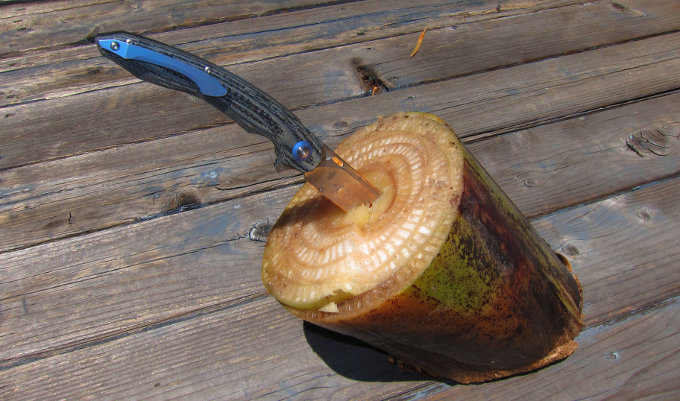
I didn’t think much about it until 2012, when I bought a DPX Gear HEST/F with a D2 tool steel blade, which sounded really cool. I decided to look up the comparative properties of D2 online, and was shocked to learn that D2 wasn’t the greatest blade steel ever invented. Between 1997 and 2012, the internet had matured into a snarky criticism/pornography e-commerce platform that highly values new products. I learned about S30V and many other new blade steels that were becoming popular thanks in no small part to the internet’s hunger for new, improved things.
So, to keep up in modern business, new powder metallurgy “super steels” like M390, S110V and Vanax 37 have become the steels of choice for high-end knives. Now, D2 blades are generally relegated to lower-priced knives. In fact, the last D2 steel knife I bought was the OKC Carter Prime, which was disappointing in so many ways. But the Carter Prime is not the knife I’m going to complain about…
Handle, Ergonomics, and Pocket Clip
The G10/carbon fiber handle is long, fat, and heavy, and fits my medium-large hands very well. As my daily EDC over the last month and a half, I’ve done a lot with it. I prepared an entire BBQ meal with the Fanga. It’s blade shape and the fact that the blade edge is higher than the bottom of the handle preclude it from being good at dicing onions, but it hacked open the packaging on the sausages and sliced the rolls just fine.
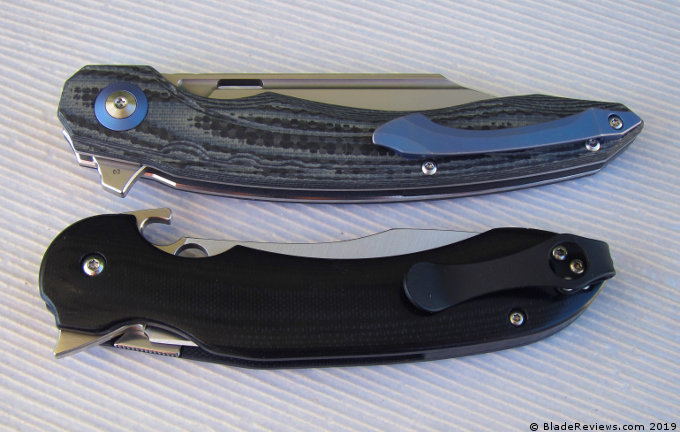
I needed to chop down a recently deceased banana tree in my yard, and why use a saw or machete when I have this bigass knife in my pocket? It was like cutting through seven inches of tough, soggy celery, and I gained a practical appreciation of the handle size and shape. The index finger cutout, along with the wide, flat thumb rest above the pivot, gave me surfaces to push and pull against as I sawed the banana trunk into sections that would fit into my yard waste bin. Afterwards, the knife and I were covered in bitter banana sap, so I cleaned us both with a garden hose. I was hoping that the Fanga’s machined G10/carbon fiber handle and G10 backspacer would be less slippery when wet than an all-titanium handled knife, but it was about as slippery as my titanium Sebenza.
Most of the time G10 appears on folding knife handles, it’s a flat slab with a square grid pattern molded or machined into the surface. It feels great and provides excellent traction, but looks boring. Notable examples of this are a lot of Spyderco knives, the Rick Hinderer XM series of knives, and pretty much every Emerson knife. But on the Fanga, this material is sculpted in a creative, organic way you that you feel more than you see.
Kombou, the designer of this knife, has added his signature design cue of several little scalloped cuts on the top of the handle behind the pivot. I’ve noticed this design in four of his other knives (the Ornetta, Volta, Kamoza, Bragga, and Buwaya) and I now notice a signature naming convention as well- all of his knife names end with an “a”. I really like his design aesthetic. It’s not quite as distinctive as knife designer Elijah Isham’s style but I find Kombou’s knives to be more practical. Like Isham, Kombou does 3D computer design, not physical knife making, and a close examination of the Fanga reveals many well-executed small details, like the deep blade fuller that can be used to open the knife like you would open a traditional slipjoint.
The pivot collar and the pocket clip are made of the same blue anodized titanium, and both have style. The pivot collar is subtly cone shaped, and the angle at which it rises above the handle matches the angle of the pivot screw, resulting in a volcano shaped pivot. The clip has a unique organic shape that compliments the shape of the handle. It also has a sufficient height above the handle to easily slide onto both my thickest denim jeans and my Triple Aught Design Force 10 AC pants which are extremely thin, but indestructible. The amount of flex in the clip has held on tight to everything I’ve worn in the six weeks I’ve been carrying the Fanga.
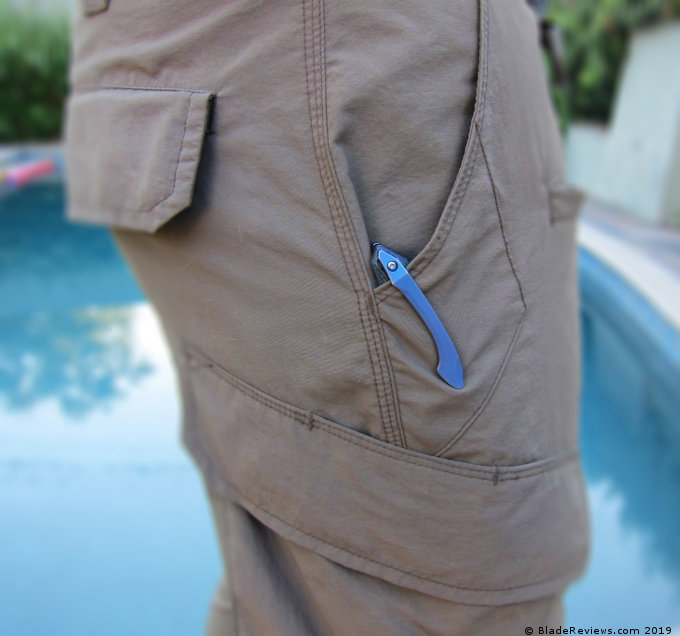
I scratched the anodizing on the clip somehow, and the blue anodizing is showing some fading on the edges. My Fox Knives Phoenix has similar blue anodizing and even more pronounced wear, but that’s also not the knife I’m going to complain about…
Deployment and Lockup
The Fanga stays open by utilizing a steel liner lock, which contributes to it’s weight. As D2 steel has gone out of fashion in high-end knives, so have liner locks been replaced by frame locks. I personally love a well done liner lock because it allows the handle design to be symmetrical in shape and materials. A frame lock knife, like the Chris Reeve Knives Sebenza, by definition must have a steel or titanium handle on one side that functions as it’s locking mechanism.
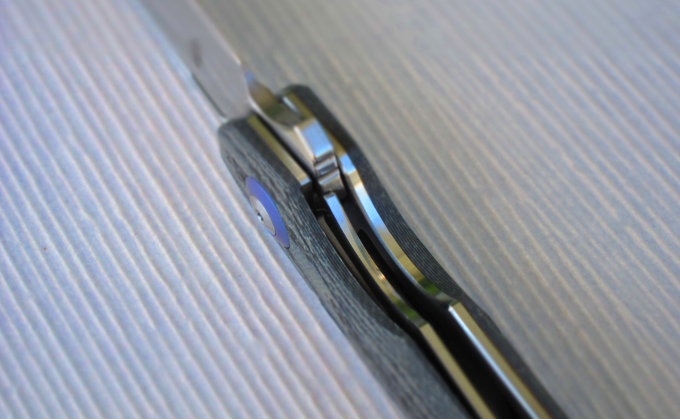
The design of the “lock side” of a typical frame lock knife is dominated by the lock. If a knifemaker wants to use a material other than steel or titanium for the non-locking side of the handle (the “show” side) they can use G10 or micarta or solid gold, but there’s no way to have symmetry of materials on both sides of the handle unless you use steel or titanium. Thanks to it’s liner lock, the standard Bestech Fanga has symmetrical G10 (or G10/carbon fiber) handles on both sides.
The lockup is solid with no blade wiggle, and the combination of the wide, heavy handle and thick blade stock prompted me to test the overall strength of the knife. My banana-watering garden hose burst at one end so I seized the opportunity to cut it with the Fanga. It took all my strength to cut through the extra-thick hose, so for the sake of science I sharpened it and cut a couple more slices much more easily.
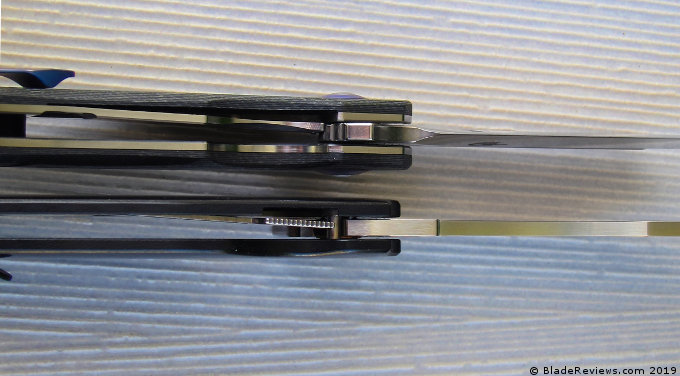
The Flipper detent is a little stronger than I’m used to, meaning that it takes a bit of effort to get the flipping motion started. Once past that initial resistance it flips open smoothly on it’s ball bearing pivot system. It’s a big heavy blade and the detent feels appropriate to get that much mass moving and locked into place. I have never failed to completely flip it open using a normal index finger technique or by my wrapping my thumb over the top like a front flipper knife.
Every surface on the Fanga that’s able to be touched is chamfered or rounded a little bit, with the exception of a sharp two inch portion the back side of the liner lock, which is a) only exposed when the knife is locked open, and b) not sharp enough to cut you anyway. I would call that a design flaw, but that’s nothing compared to the design flaw of the knife I’m going to be complaining about, the Spyderco Tropen.
On paper, the Tropen is practically the same as the Fanga with the exception of the Tropen having better blade steel. Their weight, handle size and shape, blade size and shape, and full flat grind are very similar to each other. It’s in the differences between them where the Tropen falls short. The flipper tab’s pointy top jabs into your finger, the polished G10 handle scales are slippery even when dry, and the liner lock that keeps the knife open is only 1mm, while the Fanga’s liner lock is almost double the thickness at 1.8mm. In the picture it looks like the liner locks are the same size, but I bought digital calipers specifically so I could bitch about this and I assure you the measurements are accurate.
I also replaced the pocket clip with a $26 MXG Gear deep carry clip, but that was an aesthetic decision on my part. In my opinion, Spyderco knives are like Glock pistols: they’re usually OK right out of the box, but if you really want to get the most out of them, you have to install some aftermarket accessories and tinker with them a little. My Tropen had two serious problems when it was in the closed position that definitely required some tinkering.
First, the detent keeping the Tropen closed was so weak that it opened in my pocket several times. To remedy that, I turned to YouTube and learned how to increase the detent by taking the knife apart and using a dremel tool to enlarge the hole that the detent ball rests in. The second problem has perplexed me and the knife nerd community in general- when the knife is closed, there’s a half inch of sharp blade exposed next to the lock mechanism. The only fix is to dull the back end of the blade with a file. I haven’t cut myself on it yet, and I’m leaving the end the butt end of the blade sharp just to see if it actually does cut me while I’m holding it in my pocket. I’m willing to trade the pain for the knowledge.
Finally, the Tropen costs about $100 more than the Fanga. The only reason I bring up the Tropen at all is to make my final point about price versus value.
Bestech Fanga Review – Final Thoughts
Warren Buffett said this about price versus value:“Long ago, Ben Graham taught me that ‘Price is what you pay; value is what you get.’ Whether we’re talking about socks or stocks, I like buying quality merchandise when it is marked down.” When I first held the Fanga in my hands, I was surprised that this knife only cost $102, and the regular G10 version $80. The fit and finish, at least to my untrained eye, are excellent. That’s a lot of value at a low price. There are many quality knives out there that cost approximately the same amount, but I haven’t seen one that has this much style and meticulous detail plus a milled pocket clip at this price.
I bought the very similar Spyderco Tropen (which is also made in China by the way) for approximately double the price, and it ended up costing me even more in parts and labor. Despite it’s higher price, I feel like it’s value is significantly lower than that of the Fanga. The Bestech Fanga is, in my opinion, a great all-around knife and a tremendous value for the money. I recommend it.
Lastly, while fact-checking this review with the designer, Kombou, he told me that he has recently quit his regular 9 to 5 job to become a full time Product Designer for Bestech. My congratulations to him and to anyone who gets paid to do what they love. Keep making cool knives (with good value) and I’ll keep buying them.
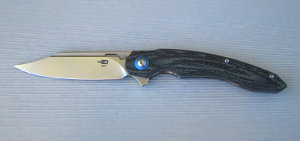
Bestech Knives Fanga – From $102.00
From: BladeHQ
Editor: I recommend purchasing the Bestech Knives Fanga at BladeHQ and Amazon. Thank you very much.
About the Author: This guest review was written by John Burridge. John Burridge is a Los Angeles-based lover of knives and other dangerous toys. He spends his days trying to make the world a better place by slipping subversive humor into reality TV shows. And playing with cats. He can be found on Instagram as @bunrudge.
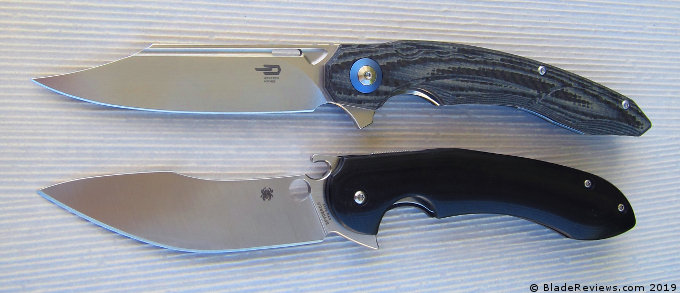
Leave a Reply